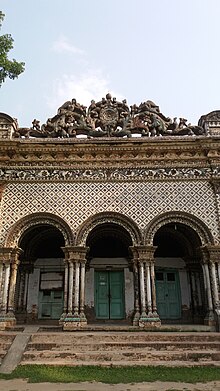This article has multiple issues. Please help improve it or discuss these issues on the talk page. (Learn how and when to remove these messages)
|
| Hemchandra Chowdhury | |
|---|---|
| হেমচন্দ্র চৌধুরী | |
 Hemnagar Palace, built by Hem Chandra Chowdhury Hemnagar Palace, built by Hem Chandra Chowdhury | |
| Born | Hem Chandra 1833 Ambaria, Madhupur, Tangail, Bangladesh |
| Died | 1915 Varanasi, India |
| Resting place | Calcutta, India |
| Nationality | Bengali |
| Education | Presidency College |
| Title | Zamindar of Hemnagar |
Hemchandra Chowdhury (1833-1915) was a Hindu Zamindar in Gopalpur Upazila in Tangail in what is now Bangladesh.
Early life
Hemchandra Banerjee Chowdhury was born in 1833 in Brahmin family of Ambaria, Madhupur Upazila, Tangail District. He was born in the Ambaria Zamindar family. His father was Kalichandra Banerjee Chowdhury a pious Brahmin. He was educated at the Presidency University in Calcutta.
Career
Chowdhury moved his residence from Ambaria to the village of Subornokhali, then an important port on the Jamuna River, and in 1890 built Hemnagar Zamindar Bari or Hemnagar Palace (also known as Parir Dalan) three kilometres to the south-east; the area was named Hemnagar after him. The palace sheltered freedom fighters during the Bangladesh War of Liberation and in 1989 the main portion was leased to Hemnagar Degree College.
Chowdhury built the first concrete road in the upazila, from Subornokhali to Jagannathganj Ghat, and was instrumental in having the railway extended to Jagannathganj Ghat in 1905. He also established the Shashimukhi English High School, named after his mother. He donated land for the construction of Gopalpur High School. He donated for the construction of Barisal School for the Deaf and Dumb, Dhaka Medical School (current name Sir Salimullah Medical College), Gopalpur Girls School, and Pingna English High School. The Barisal School for the Deaf and Dumb was established in 1911. He donated money for the construction of Mymensingh Victorial Hospital, Pingna Charitable Hospital, and the Mymensingh Hospital. He founded the Hemnagar Haradurga Devi Chowdhurani Charity Hospital in 1901. He published a periodical called Hemnagar Hitoishi. He wrote and published a number of poetry books.
Death and legacy
Chowdhury died in Varanasi in 1915, aged 82. After his death Hemnagar Union was renamed after him. Hemnagar Union, as of 2001, has 36,517 inhabitants.
After Hemchandra Chowdhury's death, his successors crossed the country in fear of communal riots during the partition of India and Pakistan in 1946. Shyamkanta Ganguly and his son Kamal Ganguly went to Hemnagar, but during the war of 1965, they also emigrated. During the Bangladesh War of Liberation, the Rajbari of Hemanagar was used as a shelter for the freedom fighters.
His current successors are living as a middle class live his great grandson (Gopesh Chandra Chowdhury(1944-2023)) was serving as a veteran in indian air force and his great great grandson is a reputed physiotherapist in the district Kanpur of Uttar Pradesh.
His descendants currently live in parts of Bangladesh, West Bengal and Other parts of the country Indiathey married into Maharaja (King) Kaliprasad Mukhopadhayay's family and the Tagore family, of which Rabindranath Tagore became the first Asian to win the Nobel Prize in Literature.
His great-granddaughter, Indrani Roy (1943-2016), continued his socialist work. She was part of the first generation of feminist Bengali poets writing after the Partition of Bengal, and one of the founding members of the Aurobindo Nari Chetana Mancha (The Aurobindo Society for Women's Empowerment), a feminist writers' society in Calcutta under the Sri Aurobindo Foundation for Indian Culture (SAFIC),
References
- ^ "Chowdhury, Hemchandra - Banglapedia". Banglapedia. Retrieved 4 February 2018.
- Ābadullāha, Muhāmmada (1987). Naoẏāba Ālī Caudhurī: jībana o karma (in Bengali). Isalāmika Phāuṇḍeśana Bāṃlādésa.
- "প্রখ্যাত ব্যক্তিত্ব | Tangail District | টাঙ্গাইল জেলা". 22 October 2016. Archived from the original on 22 October 2016. Retrieved 28 April 2020.
- Isalāma, Muphākhkhārula (1991). Tāṅgāile Isalāma (in Bengali). Isalāmika Phāuṇḍeśana Bāṃlādeśa. p. 78.
- ^ Mirza Shakil (16 April 2019). "Heritage site in a shambles". The Daily Star.
- "Illegal cattle farm operations disrupt HSC examination in Tangail". Dhaka Tribune. Retrieved 25 April 2020 – via Bangi News.
- United States Congressional Serial Set. U.S. Government Printing Office. 1924. p. 221.
- "Gopalpur Upazila - Banglapedia". en.banglapedia.org. Retrieved 28 April 2020.
- "Sri Aurobindo Foundation for Indian Culture (SAFIC)". safic.aurosociety.org. Retrieved 21 June 2018.